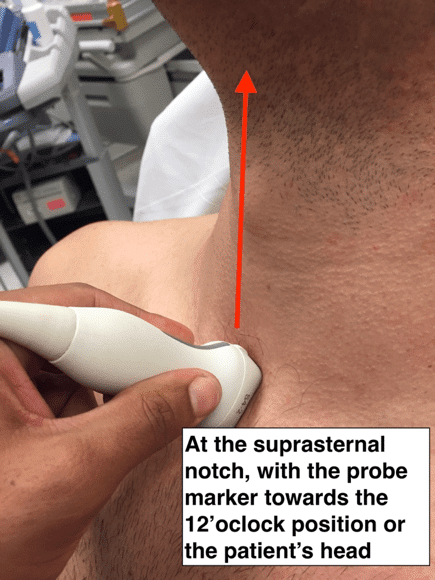Funtabulously Frivolous Friday Five 314
Just when you thought your brain could unwind on a Friday, you realise that it would rather be challenged with some good old fashioned medical trivia FFFF, introducing the Funtabulously Frivolous Friday Five 314:
Question 1
Thanks to Dr Rajasuthersan Kathirgamanathan from the Northern Hospital in Victoria, Australia for this case. A 50 year old man presents with 24 hours of shortness of breath. He describes nil other symptoms, in particular denies pain. A bedside ECHO is obtained, this is the result of the suprasternal view.
What is demonstrated here?
Reveal the funtabulous answer
Type A Aortic Dissection.
The video shows an intimal flap in the arch of aorta, the dreaded ‘silent’ dissection. This patient was promptly transferred for definitive surgical management.
Acute aortic dissection is the most common life-threatening disorder affecting the aorta. The immediate mortality rate in aortic dissection is as high as 1% per hour over the first several hours, thus early diagnosis and treatment critical for survival. 5-year survival of those left untreated is 54%.
Ascending dissections require emergency surgical repair, whereas medical therapy is usually the initial strategy for acute type B dissections. Ascending aortic dissection is most common in the 50 to 60 year age range, whereas descending dissections occur more commonly in older individuals.
Thoracic aortic aneurysms are more likely (up to 95%) to be asymptomatic than abdominal aortic aneurysms. Sixty percent occur in the root or ascending aorta.
From Boston City EM
To obtain the aortic arch from a suprasternal view, place the probe on the suprasternal notch with the marker pointed towards 12oclock. Angle the probe inferior and to the left of the patient until the aortic arch is visualized.
To obtain a better view, make small changes in position in a clockwise fashion and the outline of the arch is sharpest. We also find that putting a pillow under the shoulder blades to extend the neck is useful.

Below is another example of a dissection that is harder to see initially. The first 10 seconds show the odd impression of a flap, by adding colour doppler you can then see flow down the true lumen of the aorta and then the false lumen of a dissection becomes apparent.
Reference:
- Braverman AC. Acute Aortic Dissection – clinical update. Circulation 2010;122:184-188
Question 2
A 29yo woman presents with complains of multiple fainting episodes over the last few weeks. During conversation her partner mentions she is continuously eating ice and frost from the freezer.
Which investigation does she require?
Reveal the funtabulous answer
Iron studies, and maybe a pregnancy test.
Pica, the daily compulsive eating of food or non-food items not part of one’s habitual diet or preferences, is thought to be due to organic and inorganic causes. Compulsively eating ice specifically is called pagophagia– from Greek: pagos, frost/ice and phagō, to eat). Other manifestations of pica include:
- Geophagy: the consumption of earth,
- Rhizophagy: the consumption of uncooked rice,
- Amylophagy: the consumption of starch and uncooked pasta,
- Lithophagia: the consumption of stones.
- Other unusual types of pica have been reported, including burnt match heads (cautopyreiophagia), cigarettes and cigarette ashes, paper, cardboard, mothballs, egg shells and coins.
The most commonly discussed and published cause of pica is iron deficiency. Other causes include pregnancy, zinc deficiency and persons with obsessive-compulsive disorder.
The latin word pica indicates the magpie, that is supposed to eat indiscriminately whatever it finds. Indeed, the formal taxonomy for the Eurasian magpie is Pica pica.
Reference:
- Barton JC, Barton JC and Bertoli LF. Pica associated with iron deficiency or depletion: clinical and laboratory correlates in 262 non-pregnant adult outpatients. BMC Blood Discord. 2010;10:9.
- Borgna-Pignatti C. Pica as a manifestation of iron deficiency. Expert Review of Hematology. 2016;9(11):1075-1080
Question 3
This woman’s partner experiences presyncope in front of you during venesection. Whilst getting an initial set of observations it becomes apparent he has tripped into SVT. He fails vagal manoeuvres, thus you decide to use adenosine to chemically cardiovert him.
What food or beverage could he have had that would negatively impact your cardioversion outcome?
Reveal the funtabulous answer
Coffee
Methylxanthines, including caffeine and theophylline, antagonise adenosine by competing for adenosine 1 & 2 receptors.
In a study of 68 patients, any amount of caffeine within 4 hours (but not more than 4 hours) of a 6-mg adenosine bolus decreased its efficacy in cardioversion. A 12mg adenosine dose was not negatively affected by recent caffeine ingestion.
Reference:
- Cabalag MS et al. Recent Caffeine Ingestion Reduces Adenosine Efficacy in the Treatment of Paroxysmal Supraventricular Tachycardia. Acad Emerg Med 2010;17(1):44-9
Question 4
Which mushroom is this? Can I eat it?
Reveal the funtabulous answer
No, just no.
This mushroom is Amanita phalloides, commonly caused the Death cap. Ingestion of a single mushroom can be fatal.
Typically found under oak trees, symptom onset can be as prompt as 6 hours if a large ingestion (e.g. large serve of ‘wild’ mushroom risotto) or up to 24 hours if a smaller ingestion. Symptoms are initially gastrointestinal: nausea, vomiting, diarrhoea, abdominal pain. Death is through fulminant hepatic failure and multi-organ dysfunction, however liver transaminases may take 24 hours to begin to rise.
Management requires supportive cares, decontamination and specific antidotes:
- IV fluids for supportive cares, especially as losses may be significant
- Decontaminate with 50g activated charcoal bolus and 25g every subsequent 4 hours if no contraindications.
- Antidotes:
- Acetylcysteine infusions, and
- Silibinin – if silibinin not available then use high dose benzylpenicllin which is designed to stop the uptake of amatoxin into hepatocytes.
Reference:
- Austin Health – Amanita toxicology guideline.
- Ye Y and Liu Z. Management of Amanita phalloides poisoning: A literature review and update. Journal of Critical Care. 2018;46:17-22
Question 5
Are tic disorders, be they provisional/transient tic disorder, chronic tic disorders, or Tourette’s disease, more common in boys or girls?
Reveal the funtabulous answer
Boys.
Provisional tic disorder (previously ‘transient tic disorder’ in the DSM-IV) is actually quite common, found in anywhere from 4-20% of children. It has a male to female ratio of 2-3 : 1.
Tourette’s disease is thought to have prevalence of 3-8 per 1,000 children, with a male to female ratio of 3-4 : 1.
The average age of onset is usually 4 to 7 years old, family history plays a strong role.
…and finally


FFFF
Funtabulously Frivolous Friday Five
Dr Mark Corden BSc, MBBS, FRACP. Paediatric Emergency Physician working in Northern Hospital, Melbourne. Loves medical history and trivia...and assumes everyone around him feels the same...| LinkedIn |




I actually knew a couple of answers from this one 😄